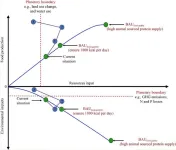(Press-News.org) Sleep and sleep disturbances have consequences for the development of adolescents and young adults. In a new article, researchers examine sleep during these periods, focusing on the effects of ethnic and racial discrimination. They conclude that improving sleep may boost health for all youth, but especially for those affected by racism.
The article, by researchers at Fordham University and the University of Illinois at Urbana-Champaign, appears in Child Development Perspectives, a journal of the Society for Research in Child Development.
“Discrimination based on ethnicity or race is a form of stress, and stress has been implicated in sleep disturbances,” explains Tiffany Yip, professor of psychology at Fordham University and the article’s lead author. “Rather than asking young people to ‘sleep off’ racism, we advocate for creating sleep-promoting programs that have direct benefits for developmental outcomes as well as indirect benefits by disrupting the negative effects of racism.”
Parents, teachers, scholars, and educational institutions agree nearly universally that sleep and sleep behaviors are important for the healthy development of young people. Sufficient and good-quality sleep is critical for overall adjustment, developmental milestones, and daily functioning for humans throughout life. Adolescence (ages 12-17) and young adulthood (ages 18-25), which feature significant physical and social changes, are critical periods for sleep health. These are also periods when discrimination is more pronounced.
Although discrimination can be based on many individual and intersecting biases (e.g., gender, sexuality, socioeconomic status, education), the authors chose to focus on discrimination rooted in ethnicity and race because of the well-founded documentation of disparities in sleep by race. In their article, they integrate research linking ethnic and racial discrimination to sleep across a variety of methods and developmental time spans.
Characterizing the ways in which discrimination stress is associated with sleep through direct effects, explanatory pathways, or stress amplification matters because identifying the exact nature of these associations can inform policies and practices related to sleep-focused interventions, the authors say. In addition to being a biological need, science suggests that sleep is also a promotive developmental resource. For example, sufficient sleep duration and good quality sleep is associated with emotion regulation, learning, and memory consolidation, all important aspects of child adjustment. Moreover, sleep is also a modifiable health behavior with documented health benefits so improving sleep can disrupt temporal associations between racism and negative effects on development.
The authors highlight various interventions to improve sleep, including school-based sleep hygiene programs, smartphone applications, and cognitive behavioral therapy. Studies show that sleep interventions can improve important components of sleep, such as total sleep duration, sleep quality, and sleep efficiency. Many of these approaches are low in cost.
“Investigations of racism and youth development must consider sleep health,” says Jinjin Yan, a postdoctoral research fellow in psychology at Fordham University, who coauthored the article. “A focus on sleep health also holds promise for mitigating the negative developmental effects of ethnic and racial discrimination on mental health, physical health, and academic outcomes.”
Preparation of the article was supported by the National Science Foundation, Directorate for Social, Behavioral and Economic Sciences, Division of Behavioral and Cognitive Sciences and by the U.S. Department of Health and Human Services, National Institutes of Health, National Institute on Minority Health and Health Disparities.
###
Summarized from Child Development Perspectives, “Developmental Links Between Ethnic and Racial Discrimination and Sleep,” by Yip, T. (Fordham University), Yan, J. (Fordham University), Johnson, S. (Fordham University), Bae, J. (Fordham University), Lorenzo, K. (Fordham University), Ruedas-Garcia, N. (University of Illinois Urbana-Champaign), Zhao, Z. (Fordham University). Copyright 2024 The Society for Research in Child Development. All rights reserved.
END
Why do some young children struggle to sit through a story one day but not the next? Why do they rush impulsively into one activity but not another? Parents and teachers often focus on individual differences as they prepare children for formal schooling, but traditional measurement approaches make it difficult to study fluctuations in children’s behavior.
In a new study, researchers sought to understand children’s impulsive and inattentive behaviors in early education classrooms by having students use wearable devices called accelerometers to collect an intensive time series of their movement at school. The study found that children modulated their ...
Nature-based climate solutions can help mitigate climate change, especially in forested regions capable of storing and sequestering vast amounts of carbon. New research published in Global Change Biology indicates that a single hurricane in New England, one of the most heavily forested regions in the United States, can down 4.6–9.4% of the total aboveground forest carbon, an amount much greater than the carbon sequestered annually by New England’s forests.
The work revealed that emissions from hurricanes are not instantaneous—it takes approximately 19 years for downed carbon to become a net emission, and 100 years for 90% of the downed carbon ...
Essential tremor, a nervous system disorder that causes rhythmic shaking, is one of the most common movement disorders. A new study published in the Annals of Neurology reveals details on the increased risk of mild cognitive impairment (MCI) and dementia that individuals with essential tremor may face.
The research represents the longest available longitudinal prospective study of rates of MCI and dementia in people with essential tremor. The study enrolled 222 patients, 177 of whom participated in periodic evaluations over an average follow-up of 5 years.
Investigators observed ...
A new study has found that Black women with poor cardiovascular health may face an elevated risk of early signs of cognitive decline in midlife.
The study, which is published in the Journal of the American Heart Association, included 363 Black and 402 white women who enrolled in the Chicago site of the Study of Women’s Health Across the Nation when they were 42–52 years old. Cognition (measured as processing speed and working memory) was assessed annually or biennially over a maximum of 20 years, with an average follow-up of 9.8 years. A composite index of cardiovascular health (Life’s Essential 8) was calculated ...
The beginning of life is shrouded in mystery. While the intricate dynamics of mitosis is well-studied in the so-called somatic cells – the cells that have a specialized function, like skin and muscle cells – they remain elusive in the first cells of our bodies, the embryonic cells. Embryonic mitosis is notoriously difficult to study in vertebrates, as live functional analyses and -imaging of experimental embryos are technically limited, which makes it hard to track cells during embryogenesis.
However, researchers from the Cell Division Dynamics Unit at the Okinawa Institute of Science and Technology ...
COLUMBUS, OHIO – A new national survey conducted by The Ohio State University Wexner Medical Center finds a broad majority of parents experience isolation, loneliness and burnout from the demands of parenthood, with many feeling a lack of support in fulfilling that role.
The survey of parents conducted this month found:
About two-thirds (66%) felt the demands of parenthood sometimes or frequently feel isolating and lonely.
About 62% feel burned out by their responsibilities ...
Traditional non-aqueous lithium-ion batteries have a high energy density, but their safety is compromised due to the flammable organic electrolytes they utilize.
Aqueous batteries use water as the solvent for electrolytes, significantly enhancing the safety of the batteries. However, due to the limited solubility of the electrolyte and low battery voltage, aqueous batteries typically have a lower energy density. This means that the amount of electricity stored per unit volume of aqueous battery is relatively low.
In a new study published in Nature Energy, a research group led by Prof. LI Xianfeng from the Dalian Institute of Chemical Physics (DICP) ...
Contemporary food systems were originally developed to tackle challenges of the mid-20th century, aiming to supply abundant, efficient, non-perishable starchy calories to accommodate the expanding global population. Although substantial progress has been made in global food security over the past several decades, there still exist large populations experiencing hunger worldwide. Currently, global hunger primarily refers to insufficient calorie intake. Hidden hunger is the presence of multiple micronutrient in the absence of an energy-deficit diet. Hidden hunger, particularly the inadequate consumption of high-quality protein, ...
An international team of researchers, led by Danielle DeLeo from the Smithsonian Institution, has identified eight organisms with previously unknown luminosity. Using genetic findings from these organisms and previous studies, they estimated that coral bioluminescence originated about 540 million years ago in the Cambrian period, making them the earliest bioluminescent organisms. During this period, they shared the oceans with invertebrates with light-sensitive eyes, hinting that interspecies interactions occurred involving light. They published their findings in Proceedings of the Royal Society B.
While shallow-water ...
SRI announced today that it has been selected by the Defense Advanced Research Projects Agency (DARPA) to deliver advanced technology for its recently launched Multiobjective Engineering and Testing of ALloy Structures (METALS) program.
DARPA METALS aims to break today’s one-material-per-part paradigm, which can lead to vulnerabilities and reduced life when highly engineered components experience austere environments. The goal of the four-year program is to develop technologies that treat material selection – particularly metallic alloys – as a continuous ...



